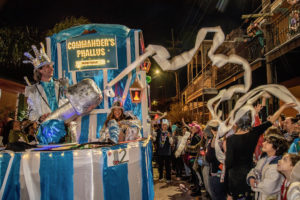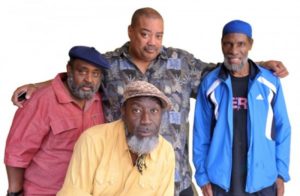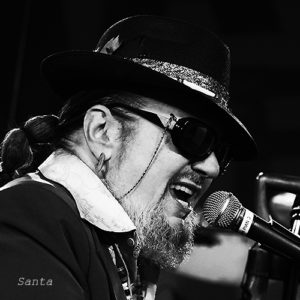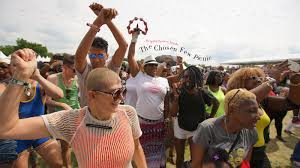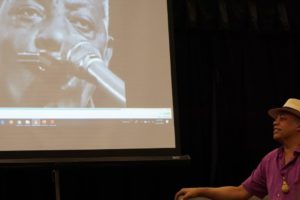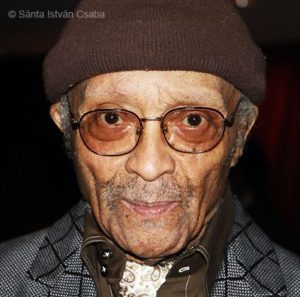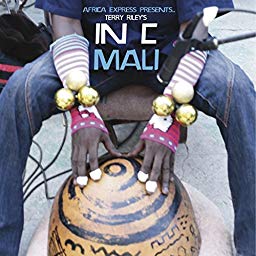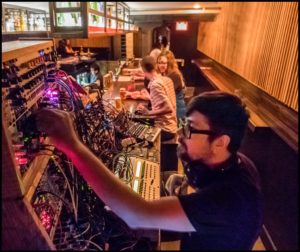Satirical, scatalogical New Orleans parade floats by Krewe du Vieux Carré, via photojournalist Marc PoKempner
Chicago Jazz fest images, echoes
The 41st annual Chicago Jazz Festival has come and gone, as I reported for DownBeat.com in quick turnaround. I stand by my lead that the music was epic — cf. Marc PoKempner‘s beautiful image of the Art Ensemble of Chicago at Pritzker Pavillion, facing east towards Mecca just before their African percussion-driven orchestral set. And […]
Transcending Toxic Times with street poetry & music
My DownBeat article about Transcending Toxic Times, the compulsively listenable, critically political album by the Last Poets produced by electric bassist/composer Jamaaladeen Tacuma, includes a lot of quotes from my interviews with him and poet Abiudon Oyewale. I reproduced some of the searing imagery/lyrics on the recording, and provided background on how these men have […]
Dr. John, Back in the Day and Blindfolded
Dr. John the Night Tripper — Mac Rebbanack, New Orleans’ musical fabulist, dead June 6 at age 77 — dazzled me at one of the first rock shows I recall attending, at Chicago’s Aragon Ballroom circa 1969. I was then enthralled by Gris-gris, his murky, obscure and carnivalesque debut album, having never heard anything like […]
Black Chicago music fest producers: The costs of “free”
Chicago offers, surprisingly enough, many opportunities to catch exciting, accomplished and emerging music across genres, with oodles of concerts free of charge, meaning they have to funded by others than attendees. Our extraordinary summer events season launched last weekend with the city-sponsored, all-free 34th Annual Chicago Gospel Festival in Millennium Park and I’m psyched for […]
Digging Our Roots videos, speakers inspire engagement
Musicians and journos with insights into historic hits can offer curious audiences low-cost interactive experiences that bond most everybody present, like any successful performance.
2018 jazz, blues and beyond deaths w/ links
Not a happy post, but a useful one: here are the hundreds of musicians and music industry activists who died in 2018, as compiled by photographer-writer Ken Franckling for the Jazz Journalists Association. Ken scoured local newspapers, the Jazzinstitut Darmstadt newsletter, AllAboutJazz.com, Wikipedia, the New York Times, Legacy.com, Rolling Stone, Variety, JazzTimes.com, blogs, listserves, Facebook pages and […]
Legacies of Music Makers
The deaths of multi-instrumentalist Joseph Jarman, best known as the face-painted shaman of the Art Ensemble of Chicago, and Alvin Fielder, re-conceptualizing drummer, remind us that artists’ contributions to music extend beyond recordings and awards. Read my essay at NPR Music, commissioned by Nate Chinen of WBGO, on the enduring legacies of Jarman and Fielder, […]
Extraordinary Popular Delusions, Chicago free improv all-stars
Keyboardist and synthesizer specialist Jim Baker has led the collective quartet Extraordinary Popular Delusions playing every Monday night in obscure Chicago venues for the past 13 years. My article on EPD, which features saxophonists Mars Williams and Edward Wilkerson Jr. (they switch off), multi-instrumentalist (bass, guitar, trumpet) Brian Sandstrom and percussionist/drummer Steve Hunt — all […]
Labor Day jazz fests, starting with Chicago’s
The 40th annual Chicago Jazz Festival, four days free to all of unfettered, usually joyous music held in beautiful downtown Millennium Park, started last night with stars of of the local scene celebrating  “Legends and Lions”. Add “Ancient to the Future” to set the tone for a weekend of exciting, civically-supported music here — and similar outpourings of jazz […]
“In C” for performance on any laptop, thanks to LUTE
Terry Riley’s 1964 ingenious, joyful and warm composition “In C” can now be performed by anyone with a laptop, regardless of their previous musical or technological experience. On Sunday 8/12/18, the Loyola University Technology Ensemble (LUTE) organized a participatory concert of the sublime communitarian piece — which comprises 53 brief melodic figures, to be played […]
Synth and-sushi bar, Chicago (future jazz, present tense)
K-rAd freely improvised and spontaneously composed an original, pulsing, burbling, chiming, floating and ripping, multi-layered, deep and flowing funky-bassed, percussion-lively suite over about three hours last night (7/25/18), using his elaborate, sound-unbound Euro-rack synthesizer setup to stir, smooth and spice social interactions in a seemingly unlikely Chicago venue for such a thing. Down an alley, through a back […]
Cecil Taylor, dead at 89, as celebrated when he’d turned 80
The brilliant, challenging, perplexing and incomparable pianist/improviser/composer Cecil Taylor died April 5, 2018, at age 89. Here’s what I wrote of him to celebrate his 80th birthday: Cecil Taylor, unique and predominant, 80 years old 3 27 09 Cecil Taylor is the world’s predominant pianist by virtue of his technique, concept and imagination, and one of […]

